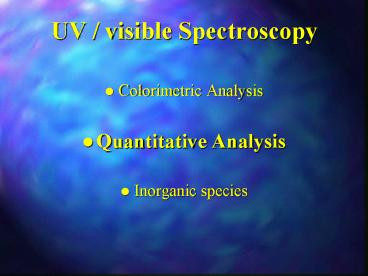UV / visible Spectroscopy - PowerPoint PPT Presentation
1 / 19
Title:
UV / visible Spectroscopy
Description:
Colorimetric Analysis Quantitative Analysis Inorganic species UV / visible Spectroscopy Two types of electronic transition Transisitions involving atomic orbitals ... – PowerPoint PPT presentation
Number of Views:940
Avg rating:3.0/5.0
Title: UV / visible Spectroscopy
1
UV / visible Spectroscopy
- Colorimetric Analysis
- Quantitative Analysis
- Inorganic species
2
UV / visible Spectroscopy
- Two types of electronic transition
- Transisitions involving atomic orbitals
- Charge transfer transitions
3
UV / visible Spectroscopy
- The ions and complexes of elements of the first
two transition series absorb broad bands of
visible radiation in at least one of their
oxidation states and are, as a consequence,
coloured.
4
UV / visible Spectroscopy
5
UV / visible Spectroscopy
- Absorption involves transitions between filled
and unfilled d-orbitals. - The energy differences between the d-orbitals
(and thus the position of the corresponding
absorption peak) depend upon the the position of
the element in the periodic table, its oxidation
state, and the nature of the ligand bonded to it.
6
UV / visible Spectroscopy
7
UV / visible Spectroscopy
- Charge transfer absorption is of particular
interest to analytical chemists because molar
absorptivities are usually large (?max gt 10,000). - Methods based upon this type of absorption are
highly sensitive.
8
UV / visible Spectroscopy
- Many organic and inorganic complexes exhibit
charge transfer absorption and are known as
charge transfer complexes. - Thiocyanate and phenolic complexes of iron(III).
9
UV / visible Spectroscopy
10
UV / visible Spectroscopy
- Charge transfer complexes generally contain both
an electron donor group and an electron acceptor
group. - Absorption of radiation involves the transfer of
an electron from the donor group to an orbital
associated with the acceptor group or vice versa.
11
UV / visible Spectroscopy
- Six criteria for a successful analysis
- Specificity of the colour reaction
- Proportionality between colour and concentration
- Stability of the colour
- Reproducibility
- Clarity of the solution
- High sensitivity.
12
UV / visible Spectroscopy
- Specificity of the colour reaction
- Very few reactions are specific for a particular
substance. - However, many only give colours for a small group
of related substances. - Therefore they can be considered to be selective.
- Alteration of oxidation states and pH enhances
selectivity.
13
UV / visible Spectroscopy
- Proportionality between colour and concentration
- It is desirable that the system under
investigation follows the Beer-Lambert law.
- Stability of the colour
- Not all complexes are stable with respect to
time. - The stability of the complex should be sufficient
to allow precise measurements to be made.
14
UV / visible Spectroscopy
- Reproducibility
- The colorimetric procedure must give reproducible
results under the experimental conditions. - The reaction need not represent a
stoichiometrically quantitiative change.
15
UV / visible Spectroscopy
- Clarity of the solution
- The solution must be free of precipitates.
- Turbidity scatters and absorbs light.
- High sensitivity
- It is desirable that the colour reaction be
highly sensitive. - i.e. ? is very large.
16
UV / visible Spectroscopy
- Steps in carrying out a colorimetric analysis.
- Choose the wavelength of maximum absorbance.
- Prepare a calibration curve using known
quantities of the complex measured at this
wavelength. - Measure the absorbance of your unknown sample.
- Calculate the concentration from the equation of
the best fit line.
17
UV / visible Spectroscopy
- Calibration Curves
y 1.2469x - 0.0219
R2 0.9992
18
UV / visible Spectroscopy
Diethyl dithiocarbamate
Diphenyl carbazone
19
UV / visible Spectroscopy
- Advantages of colorimetric analysis.
- Better at low concentrations than titrimetric or
gravimetric analysis. - Can be applied under conditions where there are
no satisfactory titrimetric or gravimetric
procedures. - Very rapid once a calibration curve as been
obtained.

